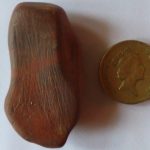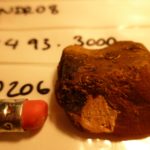Ochre is a mixture of fine clay and iron oxide and it often occurs in conjunction with iron ores such as haematite. Though it occurs at many prehistoric sites in Britain it is usually present in only small numbers. Recent excavations by Oxford Archaeology North at the Late Mesolithic site of Stainton, Cumbria has uncovered a very large assemblage of 582 pieces of ochre. This included 47 pieces with traces of working and several others with residue adhering to the surface.
The wear traces are visible as striations, gouge marks, grooves and worn faces and combinations of these various wear traces often occurred together on the larger or complete pieces. Only a few pieces of ochre appear to have been used for sustained rubbing – enough at least to alter the profile of the lump significantly. The heaviest wear traces were made by gouging and the marks were formed by pushing a sharp point into the centre of the ochre face.
A few pieces had a white substance adhering to the surface and SEM analysis by Karen Hardy, ICREA, Barcelona University has shown it to be an aluminium silicate, most likely kaolin.
There are many uses ascribed to ochre though few if any can be directly identified at archaeological sites. Ochre is a strongly coloured red or orange pigment which can be rubbed on to an object in order to colour it. It can be used either dry or wet but when a lump of ochre or haematite is rubbed with water the colour is released very easily as a red viscous liquid reminiscent of blood and which can be applied like paint (Isbister 2000). As well as a decorative application ochre can also be used in the preparation of hides (ibid) and Hodgkiss (2010) notes that high iron content preserves leather. Isbister records many ethnographic applications of ochre in medicine and healing (Isbister 2000, 2009). Kaolin also has many and varied uses and in ways similar to or complementary with ochre. These materials were clearly used together at Stainton as demonstrated by the fragments of ochre with kaolin adhering to them but without supporting residue evidence from other materials it would be futile to speculate on their exact uses.
The assemblage of ochre from Stainton is the largest and most informative yet from an excavated Mesolithic site in Britain and the distinctive range of wear traces demonstrates that ochre (and kaolin) was used in a variety of ways and most likely for different jobs. The large size of the assemblage together with the range of uses could indicate that craft, manufacturing and processing activities at this site were carried out in an intensive way; perhaps highly organised into specialised areas for e.g. hafting and hide working.






